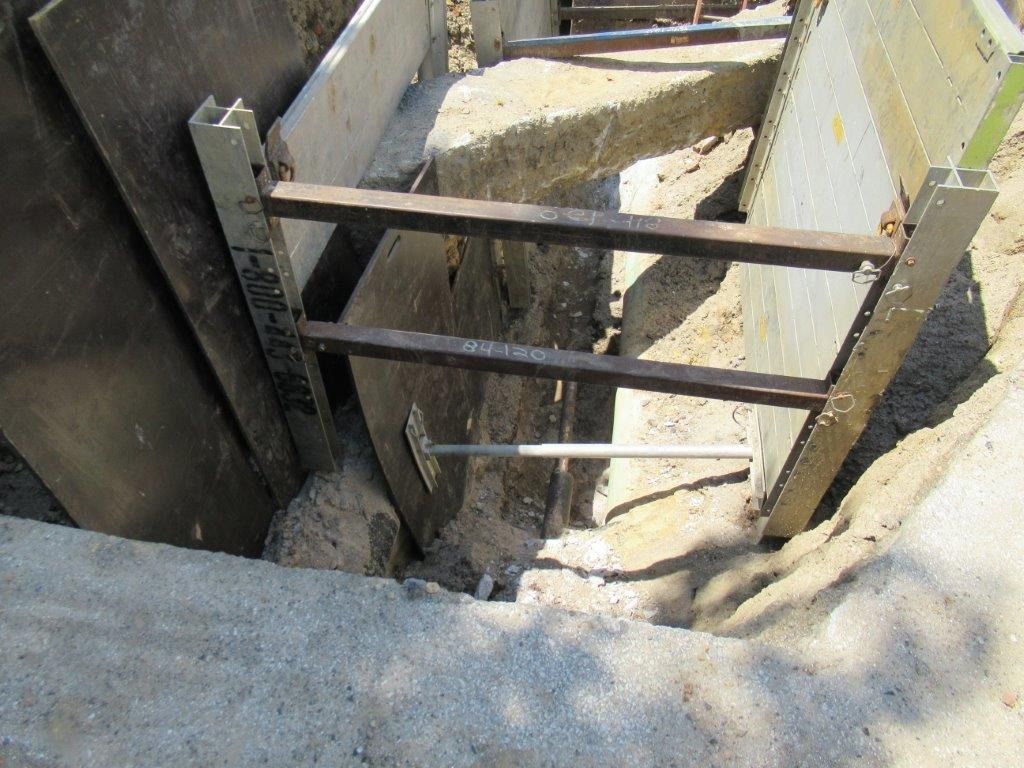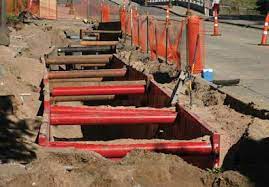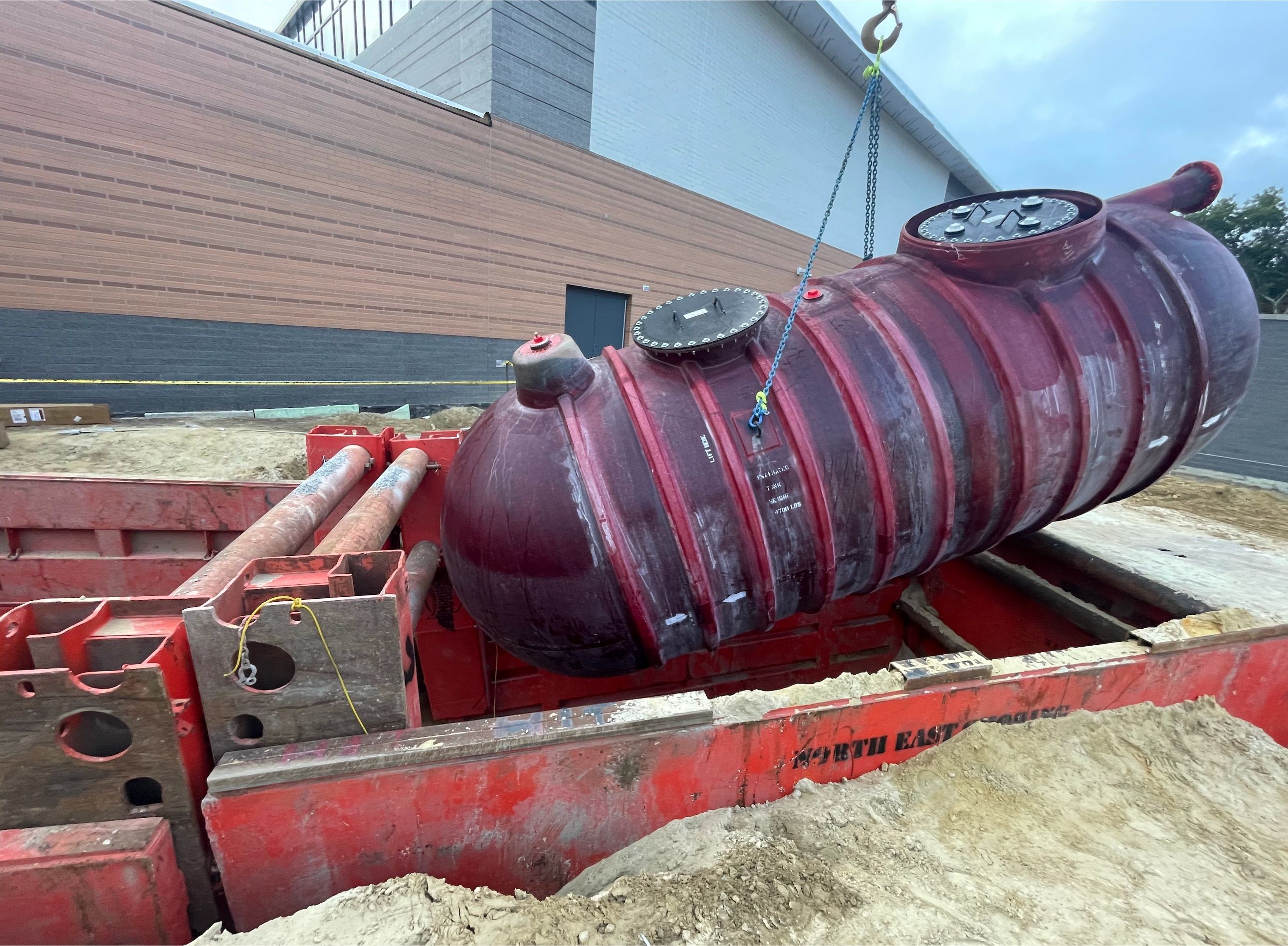Introduction
Trench box safety is essential in excavation work
Trench boxes play a crucial role in protecting workers from cave-ins and soil collapses during excavation projects. Without proper protective measures, trenches can become hazardous, leading to serious injuries or fatalities. Ensuring that trench boxes are installed correctly is one of the most effective ways to prevent these risks.
Trench collapses are a major safety concern
Soil can be unpredictable, and trench walls can cave in without warning. A single cubic yard of soil can weigh thousands of pounds, making it nearly impossible for a worker to escape a collapse. Many excavation accidents occur due to unstable trenches, lack of protective systems, or improper trench box installation.
OSHA regulations require trench protection
The Occupational Safety and Health Administration (OSHA) mandates that any trench deeper than five feet must have a protective system in place. Trench boxes help meet these requirements by preventing soil from shifting into the excavation site. OSHA also requires that trench boxes be installed correctly to ensure worker safety.
Step-by-step safety tips for proper installation
This guide provides step-by-step safety tips to help contractors and construction workers correctly install trench boxes. Following best practices can reduce the risk of trench collapses, improve efficiency on job sites, and ensure compliance with safety regulations.
Understanding Trench Box Safety
Trench boxes provide essential protection
A trench box is a safety structure designed to prevent soil from collapsing into an excavation site. It consists of two parallel panels held together by adjustable spreaders. Trench boxes are commonly used in construction, utility work, and pipeline installations to create a secure work environment for employees.
Proper installation prevents trench collapses
Even with a trench box in place, incorrect installation can lead to failures. If the trench box is not properly positioned, secured, or maintained, it may shift or become unstable. Ensuring that the trench box fits the trench dimensions and is properly supported helps reduce the risk of soil movement and cave-ins.
OSHA requirements for trench protection systems
OSHA requires that all trench boxes be designed by a qualified engineer and rated for the depth and soil conditions of the excavation. The trench box must extend at least 18 inches above the trench surface and be installed according to manufacturer specifications. If the trench is deeper than 20 feet, additional safety measures or professional inspections may be required.
Real-world cases of trench box failures
There have been cases where improper trench box installation has led to serious accidents. In one instance, a construction crew placed a trench box inside an excavation without properly securing it. When the soil shifted, the box moved, causing a collapse that trapped workers inside. Regular inspections and correct placement of trench boxes can prevent such incidents.
Pre-Installation Safety Checks
Job site inspection ensures stability
Before installing a trench box, it is important to inspect the job site for potential hazards. Soil conditions should be evaluated to determine whether the ground is stable enough to support the trench box. Trench depth and width should also be measured to ensure the box fits correctly.
Verify compliance with OSHA standards
Trench boxes must meet OSHA safety standards before being used. This includes ensuring that the box is rated for the specific trench depth and soil type. Inspecting the trench box for any visible damage, such as cracks or weakened panels, is also essential to prevent failures.
Identify potential hazards in the surrounding area
Before lowering a trench box into position, check for nearby underground utility lines, unstable surfaces, or high water table levels that may affect trench stability. Excavation sites near roads or buildings may also require additional reinforcement to prevent external pressures from causing soil movement.
Workers must be properly trained in trench safety
Proper training is critical to ensuring that trench boxes are installed and used safely. Workers should be trained on how to position, secure, and inspect trench boxes before use. Supervisors should also monitor installation to confirm that all safety measures are followed. Investing in proper training helps reduce accidents and improves overall job site safety.
Step-by-Step Guide to Trench Box Installation
Selecting the right trench box for the job
Choosing the correct trench box size and type is the first step to a safe installation. The trench box should be appropriate for the excavation depth and soil conditions. Steel trench boxes are ideal for deep and heavy-duty projects, while aluminum trench boxes work best for shallower trenches or jobs requiring frequent movement of the box. Ensuring the right size and type prevents unnecessary adjustments and improves safety on the job site.
Placing the trench box correctly
Once the appropriate trench box is selected, it should be positioned as close as possible to the trench opening. This reduces unnecessary movement and makes the installation process smoother. Using a crane, backhoe, or lifting straps, carefully lower the trench box into the excavation. The box should be set gradually to avoid sudden shifts or instability. Proper placement helps minimize risks and keeps the trench box stable before workers enter.
Ensuring the trench box is stable
Before allowing workers into the trench, the trench box must be checked for stability. The box should be level to prevent tilting or shifting during work. Spreaders and panels must be adjusted to fit the trench dimensions, ensuring a secure fit. Backfilling around the trench box adds an extra layer of support, reducing movement and increasing stability. A properly secured trench box provides a safe working environment and prevents soil collapses.
Creating a safe entry and exit plan
Workers should only enter and exit the trench using ladders or designated access points. A clear exit route must always be available in case of an emergency. Workers should never attempt to climb on or over trench box walls, as this increases the risk of falls and injuries. Assigning a supervisor or spotter to monitor worker movement inside the trench ensures that safety protocols are followed and that immediate assistance is available if needed.
Real-world example of proper trench box installation
A construction crew in Massachusetts successfully avoided a potential trench collapse by taking extra precautions before excavation began. The team carefully positioned and secured the trench box, ensuring it was level and stable. The site supervisor performed a final stability check and reinforced the trench walls before allowing workers inside. This attention to detail helped prevent soil movement and created a safe working environment for the crew.
Common Trench Box Installation Mistakes to Avoid
Placing the trench box incorrectly causes instability
A trench box must be centered within the trench to provide even support on all sides. If it is positioned too far to one side, the unsupported area can become weak, increasing the risk of soil movement or collapse. Before securing the trench box, contractors should check that it is properly aligned and fully enclosed within the excavation area.
Failing to secure the trench box increases collapse risks
A trench box that is not properly stabilized can shift or move, putting workers at risk. Spreaders should be securely adjusted to fit the trench dimensions, and the trench box should be backfilled for extra support. Loose trench boxes may also create gaps where soil can fall inside, making the excavation site unsafe.
Overloading the trench box can weaken its structure
Stacking heavy materials, tools, or equipment against the walls of the trench box can put unnecessary pressure on its structure. Trench boxes are designed to withstand lateral soil pressure, but excessive weight from within can weaken the walls and reduce their effectiveness. Contractors should ensure that trench boxes remain clear of excess loads to maintain their strength and integrity.
Ignoring soil conditions creates unsafe work zones
Soil type plays a critical role in trench stability. Loose or sandy soil requires additional reinforcement, such as trench shields or additional backfill, to prevent shifting. Hard, compacted soil may require a stronger trench box to handle the weight. Ignoring soil conditions can lead to unexpected trench collapses, putting workers at serious risk.
Pro tip for trench box safety
Before every use, inspect the trench box for any damage, misalignment, or missing parts. Never assume that previous installations were done correctly. A thorough check before installation ensures a safer excavation site and reduces the chance of accidents.
Best Practices for Trench Safety Compliance
Maintain detailed records of trench inspections
Keeping accurate records of trench inspections helps ensure compliance with OSHA regulations. Inspections should include details about soil conditions, trench depth, and the condition of the trench box. These records can also be useful for tracking maintenance and identifying potential hazards.
Train workers in OSHA trench safety protocols
All workers involved in trenching and excavation should be trained in proper safety procedures. OSHA requires training on trench box installation, soil classification, and emergency response protocols. Well-trained workers are better prepared to recognize hazards and take the necessary precautions to stay safe.
Use protective barriers and warning signs
Excavation zones should be clearly marked with barriers and warning signs to prevent unauthorized access. This is especially important for job sites near roads, sidewalks, or busy work areas. Proper signage helps keep workers and bystanders safe by preventing accidental entry into hazardous zones.
Perform daily trench box stability checks
Before work begins each day, contractors should inspect the trench box to ensure it remains stable. Changes in weather, soil conditions, or job site activity can affect the trench box’s stability. Daily checks help identify potential risks before they become serious safety concerns.
Where to Get OSHA-Compliant Trench Boxes
North East Shoring provides reliable trench box solutions
For contractors looking for trench boxes that meet OSHA safety standards, North East Shoring is a trusted provider of trench protection equipment. They offer a wide selection of steel and aluminum trench boxes for both sale and rental, ensuring that businesses can find the right solution for their specific needs.
Same-day delivery and flexible financing options
North East Shoring understands that excavation projects require fast and reliable access to equipment. They provide same-day delivery options, helping contractors stay on schedule without delays. For those looking to purchase trench boxes, financing options are available to make acquiring the necessary equipment more manageable.
Get a free quote for your trench protection needs
Contractors can easily request a free quote to determine the best trench box for their project. Whether renting for a short-term job or purchasing for long-term use, North East Shoring offers expert guidance to help businesses make the right choice. Contact their team to discuss trench box options and ensure a safe excavation site.
Conclusion
Proper trench box installation ensures worker safety
Installing a trench box correctly is one of the most important steps in protecting workers during excavation projects. Following best practices helps reduce the risk of trench collapses, keeps job sites compliant with OSHA regulations, and creates a safer work environment.
Routine inspections and OSHA compliance are essential
Contractors should prioritize daily inspections, worker training, and compliance with trench safety guidelines. Keeping up with these practices not only protects workers but also helps avoid costly fines and project delays.
Contact North East Shoring for expert guidance
For contractors looking for high-quality trench boxes, North East Shoring provides reliable rental and purchase options. Contact their team today for expert advice and a free quote to find the best trench box for your next excavation project.




